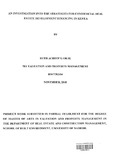An Investigation into the strategies for commercial real estate development financing in Kenya

View/
Date
2010-11Author
Okal, Ruth Achien'g
Type
ThesisLanguage
enMetadata
Show full item recordAbstract
Real estate is the largest asset class in the world. For example Johnstone (2004) observed that
the value of housing in the United States of America alone was Sixteen Trillion United States
Dollars. Other authors have claimed that real estate is the greatest source of wealth for most
families and makes up to 50% of the world's wealth. Njiru (2003) as cited by Muchiri (2006)
indicates that in Nairobi, Kenya, land was estimated to have a value of Kenya Shillings One
Hundred and Forty Billion as at the year 2003.
The purpose of this study is to investigate the strategies adopted in financing commercial real
estate development or investment in Kenya and specifically to examine their accessibility and
affordability. Investments in commercial real estate require huge financial outlays and once
the funds are invested, the resources are sunk. Liquidating the full investment will usually
take months or in some cases years. Based on the foregoing, an investor in real estate usually
takes in addition to the normal business risk, a liquidity risk. In seeking a return on his
investment, usually as rent and capital gains, an investor will then seek to be compensated for
this additional risk. Hence the financing strategy must the comprehensively considered for the
investment to be economically viable.
The study adopted the deductive approach as it defined the overall scope of the project. Both
primary and secondary data were collected through review of existing literature,
questionnaires, interviews and site visits. The results were analysed and presented using
statistical package for social studies (SPSS) version 12.
The study found out that factors such as minimal economic performance and the Retirements
Benefits Regulations of (2000) have considerably reduced the amounts that the government
and pension funds can invest in real estate. This model has left the role of real estate provision
in the hands of private sector with limited sources of equity funding. Most aspiring real estate
investors were also not well versed with the financing options available to them. This led
some entrepreneurs to opt for some financing options which have proven to be very costly in
terms of financial costs. This led in turn to delayed completion dates, occupancy dates for
prospective tenants or purchasers hence the investors incurred huge financial losses and
penalties including auction of the property used as security.
IX
The problem of real estate financing in Kenya is aggravated by scarcity of money which is
brought about by lack of security for borrowing, the high and fluctuating interest rates and the
problems of maturity profile brought about by deposits and loan mismatch. Financing
institutions in Kenya overwhelmingly relied on public deposits which were mostly short term
in nature while lending for real estate investments are long term in nature. There is therefore a
mismatch between borrowing short and lending long, which eventually pushed up interest
rates and tended to lower the loan periods. Because of the limited financing options, the real
estate industry has been characterised by rigid financing conditions and relatively high
interest rates.
On the other hand, the research also revealed that most investors in Kenya considered real
estate a good investment class and were striving to make whatever equity resources that they
have go as far as possible in acquiring real estate investments. Thus, relatively small noninstitutional
investors mostly had limited equity and relied more on debt financing to acquire
real estate, since it was difficult for them to acquire additional equity funds in any organised
and liquid market.
Kenya lacks the secondary mortgage market and other modem forms of property financing
like Real Estate Investment Trusts (REITS) which could go a long way to increase investment
in real estate sector. This would alleviate the illiquidity and indivisibility risks. Other
solutions were found to be through innovative financing strategies which should be aimed at
the small and medium enterprises and the specialised groups like Muslims and women who
have been left out in the financing sector for long. This would increase the accessibility and
affordability of real estate financing and increasing the supply of commercial real estate.
Citation
Master of Arts in Valuation and Property Management In The Department Of Real Estate and Construction ManagementPublisher
University of Nairobi
Description
Project Work Submitted In Partial Fulfillment for the Degree
Of Master of Arts in Valuation and Property Management In
The Department Of Real Estate and Construction Management,
School of Built Environment, University Of Nairobi.
